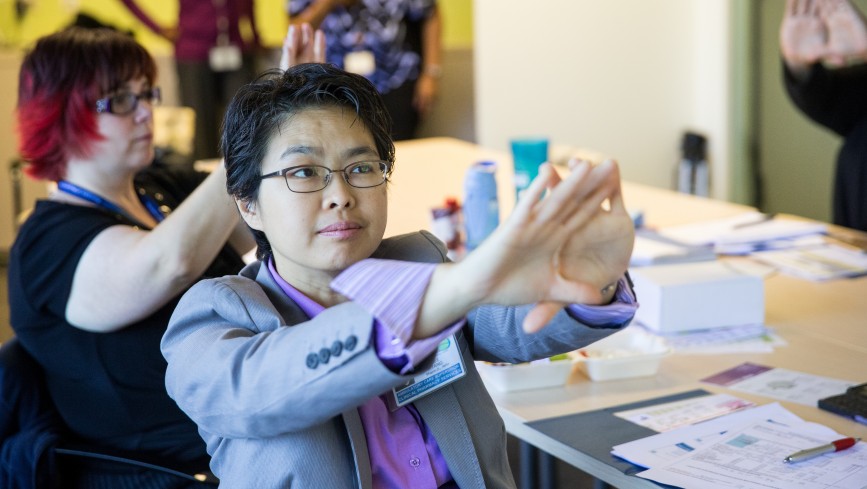Injuries Nearly Vanish After Workers Find Their Voice
Why We Speak Up

"ALL HERE FOR EACH OTHER": By working together, the pharmacy team built trust and dramatically decreased injuries. Shown here, left to right: Nachelle Walker, Clinical Pharmacy Services manager; Ramee Chambers, a Transitional Care manager; and Chakana Mayo, a pharmacy technician and UFCW Local 770 member who is also the team’s workplace safety champion.
Workplace injuries vanish almost entirely after these pharmacy workers find their voice
Angela Chandler and Nee Tang, Pharm.D., didn’t like what they were seeing.
The team co-leads for the West Los Angeles Ambulatory Care Pharmacy crouched beside Camille Wong, scrutinizing her posture as the pharmacist and UNAC/UHCP member sat typing at her computer.
After a quick huddle, the pair worked together to adjust Wong’s chair until she was sitting in the ideal position to protect her from pain—and a potential injury.
“I didn’t know I could adjust my chair this way. It feels good,” Wong said appreciatively, her feet resting flat on the floor and her legs bent at the appropriate 90-degree angle.
Shift in culture
Such peer safety rounds are one of the hallmarks of a dramatic shift in culture for the team, a shift that has built engagement and created a workplace where frontline workers feel confident speaking up. The department went 3½ years without injuries and earned a national workplace safety award earlier this year.
“We’re all in it together, and we’re all here for each other,” says Chakana Mayo, a pharmacy technician and UFCW Local 770 member who is the team’s workplace safety champion.
But the situation was not always so bright.
In 2011 and 2012, the department experienced a spate of workplace injuries. Employees, who spend most of their time on phones and computers, were sometimes reluctant to report pain—including one who suffered a repetitive motion injury so severe that it required two surgeries and time off from work.
“It was really a wake-up call,” says Tang, a pharmacy supervisor and the team’s management co-lead. “We needed to make sure that everyone feels comfortable enough to speak up when they have a problem.”

Training and peer rounding
Team members responded by developing the rounding program in 2012, with training and support from an ergonomist. Under the program, colleagues round on colleagues, with pharmacists and pharmacy technicians teaming up to check in with every employee every month. And they know safety risks when they see them: 80 percent of the department’s 38 staff members are trained as Level 1 ergonomic assessors.
Initially, team members conducted the rounding sessions without managers, worried that workers wouldn’t feel safe speaking up. But as managers acted on employees’ concerns, resolving 94 percent of workplace safety issues within 90 days of identification, the fears dissipated. Now union-represented workers round side by side with managers, who are key to instituting changes.
Team leaders “built trust with employees,” says Chandler, a pharmacy technician and UFCW Local 770 member who is the team’s union co-lead. “Team members know we’re looking out for their well-being. Now people are open and engaged.”
“Once we brought in management,” says Mayo, “we were able to do things together, and it turned out for the better.”
Helping new employees
That open, engaged culture helps the team address problems quickly.
In February, the department experienced its first workplace injury since 2012. The employee, new to Kaiser Permanente and the team, was afraid to speak up about her pain. A co-worker eventually brought her discomfort to light, enabling her to receive treatment and prompting a fresh round of safety training.
Chandler points to the experience as evidence that the team’s approach is working.
“People are speaking up on behalf of their co-workers. This is a success story,” says Chandler. “With all of our safety rounding, this is a gap that we did not foresee. Now we have an opportunity to engage new employees.
